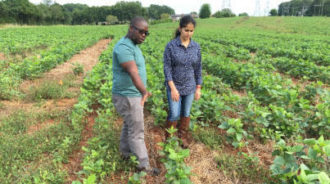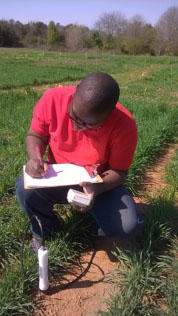CLEMSON, South Carolina – Among the myriad of benefits cover crops provide to a row crop or vegetable operation, Clemson University researchers have found another one: Cover crops do not deplete water stored in the soil profile, thus preserving the precious resource for the cash crop – an all important function, specifically in times of drought.
In the Southern Sustainable Agriculture Research & Education (SSARE) On-Farm Research Grant-funded study (OS16-096), “Cover Crop Influence on Stored Water Availability to Subsequent Crops,” researchers evaluated common fall cover crops grown in the state for water use efficiency and biomass production.
“We need to bring biodiversity to our farming systems to alleviate drought stress, and cover crops are one practice that provides the benefits to achieve that,” said Ricardo St. Aime, a Master’s student and Fulbright Scholar from Haiti who worked on the project. “But many farmers are hesitant to adopt cover crops. One reason is that they fear cover crops might bring water resource competition for the following cash crop. We conducted this study to determine whether or not this is true.”
In the two-year study, St. Aime, along with principal investigator Sruthi Narayanan, compared seven cover crop treatments to two controls (a weedy fallow field and a weed-managed fallow field). The cover crop treatments covered the three major categories: grasses, legumes and brassicas.
They included:
- Single species of rye;
- Single species of crimson clover;
- Mixture of crimson clover and turnip;
- Mixture of oat and radish;
- Mixture of crimson clover and rye;
- Mixture of oats, wheat, crimson clover, radish and turnip;
- Mixture of Austrian winter pea, rye, crimson clover, hairy vetch and oats.
Soil water content was evaluated starting from 74 days after cover crops planting and measured at various depths, ranging from 4 inches to 39 inches. Biomass was hand harvested at 83, 111 and 137 days after planting to determine dry weight.
“Cover crop water use efficiency was estimated as the amount of dry biomass produced per unit of water used during the growing period,” said Narayanan, an agronomist with the Department of Plant and Environmental Sciences. “Identification of high water use efficient cover crops, as a single species or in a mix, helps identify cover crops that produce large amounts of biomass, use less water, or a combination of both.”
Researchers found that all cover crop treatments, both in the vegetative stage and the flowering stage, retained more or equal amounts of soil moisture compared to the controls. Even after one month after cover crop termination, results showed that soil moisture was still available for use by the cash crop.
“This does not support the perception that cover crops will deplete soil moisture, which would lead to water stress for the following cash crop,” said St. Aime.
In terms of the performance of the cover crop treatments, researchers found that the best ground covers were the single treatment of cereal rye and the cover crop mix of Austrian winter pea, rye, wheat, crimson clover, hairy vetch and oats. The worst ground cover was the single treatment of crimson clover, the two-mix treatment of oat and radish, and the two-mix treatment of turnip and clover.
The five cover crop mix (Austrian winter pea, rye, wheat, crimson clover, hairy vetch and oats) and cereal rye were also two of the best cover crops for biomass production. The single crimson clover treatment produced the least amount of biomass.
“The findings emphasize that it’s important to incorporate a grass, legume and brassica for the best cover crop mixture,” said St. Aime. “Grasses produce high biomass and catch nutrients, legumes fix nitrogen, and brassicas are good for biofumigation and alleviating compaction. For more residue, grow either cereal rye or a mix of all three functional groups. Although turnips and crimson clover didn’t use much water, they are poor biomass and ground cover producers.”
Of the two five-combination cover crop mixtures, the Austrian winter pea-rye-wheat-crimson clover-hairy vetch-oats mix outperformed the oats-wheat-crimson clover-radish-turnip mix in terms of biomass production, said St. Aime. Researchers suspect rye in the mix made the difference.
Researchers hope that the results will help farmers develop a cover crops package that will optimize biomass while conserving moisture for subsequent crops.
Narayanan has received a second SSARE On-Farm Research Grant (OS18-118), “Cover Cropping to Increase the Sustainability of Cropping Systems by Developing Soil Organic Matter, Improving Soil Health, and Suppressing Weed Growth,” to study the effect of cover crops on soil health and soil compaction. Researchers are taking the best soil water conservation cover crops and determining how well they conserve soil nutrients, increase organic matter, improve soil health, and suppress weed growth for the subsequent cash crop.
Other project participants included: farmer Daniel Millam, professor Geoffrey Zehnder, assistant professor Dara Park, and area agronomy agent Christopher Talley.
Published by the Southern Region of the Sustainable Agriculture Research and Education (SARE) program. Funded by the USDA National Institute of Food and Agriculture (NIFA), Southern SARE operates under cooperative agreements with the University of Georgia, Fort Valley State University, and the Kerr Center for Sustainable Agriculture to offer competitive grants to advance sustainable agriculture in America's Southern region. This material is based upon work that is supported by the National Institute of Food and Agriculture, U.S. Department of Agriculture, through Southern Sustainable Agriculture Research and Education, under sub-award numbers OS16-096 and OS18-118. USDA is an equal opportunity employer and service provider. Any opinions, findings, conclusions, or recommendations expressed in this publication are those of the author(s) and do not necessarily reflect the view of the U.S. Department of Agriculture.
View Related SARE Grants:
- Cover Crop Influence on Stored Soil Water Availability to Subsequent Crops (OS16-096)
- Cover Cropping to Increase the Sustainability of Cropping Systems by Developing Soil Organic Matter, Improving Soil Health, and Suppressing Weed Growth (OS18-118)

